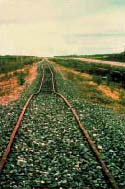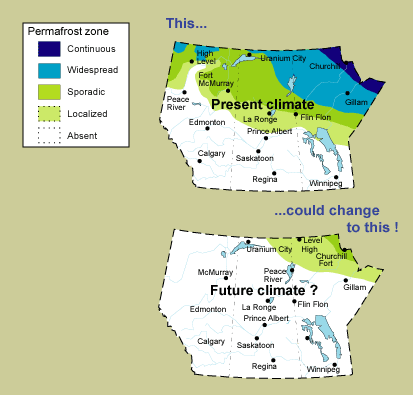Proactive disclosure
Print version   |  | 
Natural Resources Canada > Earth Sciences Sector > Priorities > Climate Change Impacts and Adaptation > Climate Change in Canada
The winds of change: Climate change in Prairie Provinces Life in the North
Polar bears on thin ice
Polar bears in western Hudson Bay annually migrate between the mainland and the sea ice to feed on seals in winter and spring. During summer and fall, Hudson Bay is open water so the bears return to land for four months or more to live off their stored fat reserves. Thus, the health of the polar bear population in this region is affected by the distribution and annual duration of sea ice. Earlier break-up of sea ice, due to warmer temperatures, limits hunting opportunities for polar bears by forcing them to come ashore earlier. Since 1981, the condition of adult polar bears in western Hudson Bay, particularly adult females, has declined significantly because they have less time on the ice in spring to feed on seals before beginning their annual fast.

(NRCan photolibrary) |

Winter range of female polar bears in western Hudson Bay (1991-1998)
(Stirling et al., 1999) |
Living with frozen ground
Permafrost, or frozen ground, is soil or rock that remains below 0░C throughout the year. Part of northeastern Manitoba lies in the zone of continuous permafrost, where permafrost is found almost everywhere except beneath lakes, rivers, and other wet areas. In areas farther south, permafrost is less abundant - and may be widespread, sporadic, or localized. Warmer air temperatures will lead to thawing of permafrost and create unstable ground conditions. Building foundations, roadways, railways, pipelines, and other structures are vulnerable to shifting, or settlement of the ground caused by thawing of permafrost.

Railroad tracks warped due to thawing of permafrost, near Gillam, Manitoba
(Erik Nielson, Manitoba Geological Survey) |

(Kettles et al., 1997) |
Did you know?
As the Earth warms, temperature changes are anticipated to be greater in the North, and greater in winter than in summer.
References
Kettles, I.M., Tarnocai, C., and Bauke, S.D., 1997: Predicted permafrost distribution in Canada under a climate warming scenario; in Current Research 1997-E; Geological Survey of Canada, p. 109-115.
Stirling, I., Lunn, N.J., and Iacozza, J., 1999: Long-term trends in the population ecology of polar bears in western Hudson Bay in relation to climatic change; Arctic, v. 52, p. 294-306.
|
